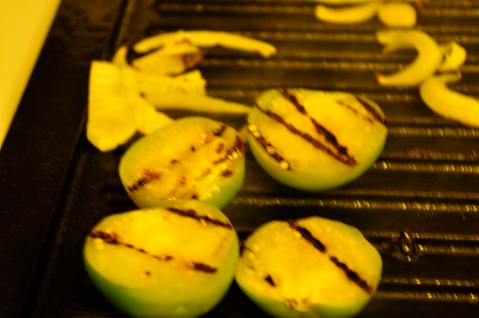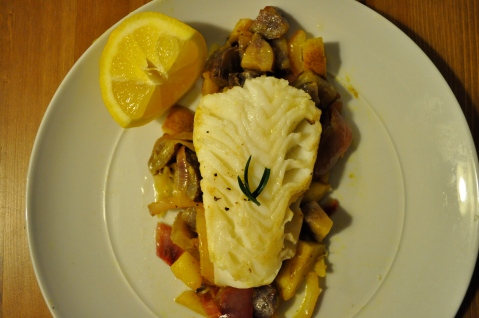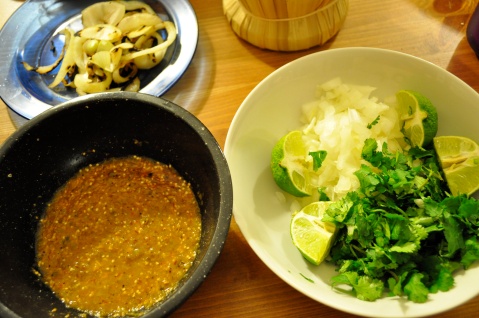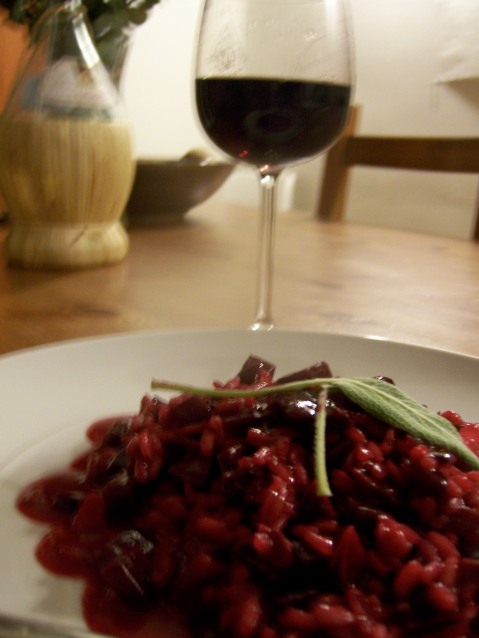Pan-roasted Sea Bass and Potato-Pear Salad
This is an easy meal to throw together, but somehow I still managed to use every dish in the house. But that’s nothing new. Despite the hour of dish-doing Gabe had to endure, I’d say the meal was completely worth it. The pear-potato salad was an epicurious.com find, and I altered it slightly, but nothing significant. The lemon juice, curry powder, and pears brought a new brightness to the potatoes. It’s as if someone pulled up the blinds, kicked the potatoes out of bed, and made them play the tuba.
Anyways, it’s good, and it’s easy. I pan roasted the sea bass, which is a pretty great way to cook most hearty proteins, I’ve found.
Pear-Potato Salad
Adapted from the New American Table via epicurious.com
1/4 c. olive oil
1 pound purple potatoes, peeled and cut cut into 1/2-inch pieces
2 pears, peeled, cored, and cut into 1-inch pieces
1/2 red onion, thinly sliced
1 garlic clove, minced
1/4 c. blanched almonds, chopped
1 1/2 tsp. curry powder
salt and pepper
juice from 1 lemon
Heat the olive oil in a large pan over medium heat. Add the potatoes and cook until tender, about 12 or so minutes. Add the pears, onion, garlic, almonds, and curry powder, and saute for 5 minutes. Season with salt and pepper and lemon juice.
Pan-roasted Sea Bass
2 sea bass filets, about a pound each
salt and pepper
2 tbsp. olive oil
juice of 1/2 lemon
Preheat oven to 450 degrees.
Bring the sea bass to room temperature and season with salt and pepper. Heat the oil in an oven-proof (cast iron works well) pan on high until it starts to smoke a bit. Place the filets in the pan, skin side down, and sear for 4-5 minutes, until the skin is crispy. Flip and cook on the other side for 30 seconds. Place the whole pan in the oven for 3-4 minutes, until it is cooked through, but still breaks into luscious flakes with your fork.
Finish by seasoning with lemon juice.
So, how did I manage to make so many dishes?
Spinach Pesto Dip
You can’t argue with spinach. You just can’t. It’s amazingly good for you (vitamin C, betacarotene, folate, calcium). It’s available year round, but best in the winter and spring (and I love a vegetable that makes a proper showing when all the other produce has flown south for the winter). It freezes well. And you can do a thousand things with it. Oh, did I mention it is delicious?
It is especially delicious in this spinach pesto dip, which is made with leftover arugula pesto (and don’t get me started on how much I love arugula, spinach’s more fragile, but supremely tasty cousin). You of course can substitute the homemade arugula pesto for any pesto you might happen to have, but this arugula pesto recipe is a really good one to have in your repertoire anyways, so you might as well master it. Once you do, it works on pasta, sandwiches…and in dips!
So, on to the dip. This is a lighter version of the standard spinach dip. No mayonnaise or butter. Just cream cheese and good stuff.
Arugula Pesto
approx 2 c. arugula (I like wild, but baby works too)
1 clove garlic
1/2 c. walnuts
zest of 1/2 lemon
1 c. grated parmesan cheese
salt and pepper
1 c. olive oil (or until you achieve desired consistency)
Place first six ingredients in a food processor and blend. Drizzle in olive oil until desired consistency. Adjust seasonings to taste.
Spinach Pesto Dip
1 package of frozen spinach
1/4 c. water
1 8 oz. package of cream cheese
1 c. arugula pesto
1 lemon, zested and juiced
salt and pepper
Bring water and a pinch of salt to a boil in a small pot and steam frozen spinach for 2-3 minutes, covered, until tender. Remove from heat and transfer to a colander. With a few paper towels, squeeze out the excess moisture.
In food processor, combine the rest of the ingredients with the spinach and mix until you have a creamy texture. Season to taste.
Serve with chips, crackers, pita, or just shovel entire handfuls into your mouth.
Epic Chicken and Waffles
I love days off, I love waffles, and I love my friends. So a day that combines all three ranks pretty high in my book. Melissa and I had Martin Luther King Day off, and I had a new waffle maker that I was itching to try, so we hatched a plan to feed our friends in fine form: chicken and waffles. I grew up in LA, so this combination, though strange to many Chicagoans, is quite nostalgic to me. Many a weekend was spent waiting in line for Roscoe’s in Hollywood, waiting for that savory-sweet magic that is the waffle and its sidekick, fried chicken.
I don’t know exactly what it is about this combination that makes it work so beautifully. There’s something gluttonous and indulgent about it that is certainly attractive–especially for a day off; but also it has a curiously balanced layering of textures (crispy and soft) and flavors (mapley and meaty). Maybe that’s it: the meeting of two worlds that have no reason to be thrown together, yet once they have been, they bring out qualities in each other that wouldn’t be discovered if eaten alone. The fried drumstick and the Belgian waffle do just fine on their own, of course, but introduce them to each other and this meal becomes a whole other beast–not breakfast, not lunch, but a sleepy Sunday marriage of the two that makes you want to loll around and laugh with friends and maybe not do much all day but help yourself to another serving.
Division of labor broke down into me doing the waffles and Melissa doing the chicken. I started out with a cranberry compote, inspired by Smitten Kitchen’s cranberry syrup.
Cranberry Compote
1/2 c. sugar
3/4 c. cranberries (fresh or thawed frozen)
1/2 c. water
1/2 vanilla bean
zest of 1 lime
1/2 c. orange juice
Cook the sugar over medium in a dry pan until it begins to turn brown. Stir it until it caramelizes completely.
Carefully add the cranberries and water (the caramel turned instantly in to a hard, plasticky lump and then quickly melted back to liquid). Stir until the caramel dissolves. Add the scraped vanilla from 1/2 a bean, the lime zest, and orange juice. Reduce for about 7 minutes, until the liquid is desired syrup consistency and cranberries have opened and softened. Mash with fork and transfer to a serving container.
Then I made the Classic Belgian Waffle recipe that came with the machine:
(It’s quite a machine, no?)
Classic Belgian Waffles
1 1/2 cups water
2 1/4 tsp. active dry yeast
3 c. sifted flour
1/4 tsp. salt
3 large eggs, separated + 1 egg white
1/3 c. sugar
1 1/2 c. whole milk
8 tbsp. unsalted butter, softened
2 tsp. vegetable oil
2 tsp. vanilla extract
Heat 1/2 of the water to lukewarm (105 to 110 degrees). Dissolve the yeast with a pinch of sugar. Let stand 5 to 10 minutes, until the mixture begins to foam.
Put the flour and salt into a large bowl; stir to blend and reserve.
In a separate bowl, combine the egg yolks and one egg white, sugar, and the yeast mixture. Stir to blend. Add the remaining water, milk, butter, oil, and vanilla. Stir until smooth. Slowly add the flour and beat until the mixture is smooth.
Beat the egg whites until stiff peaks form (the fun part!). Fold the egg whites gently into the batter. Let the batter stand for 1 hour, stirring every 15 minutes.
Preheat your waffle maker and follow instructions to make delicious, fluffy crowd pleasers!
And now for the story behind the chicken and its recipe by guest blogger, the lovely and talented Melissa!
I have quite the contentious relationship with meat. Being a vegetarian during college while at the same time learning how to cook, I never learned the necessary skills concerning meat preparation and execution. Cooking vegetables is easy; you do not have to worry about accidentally sending someone into a three-day intestinal cataclysm because you didn’t get a carrot up to 165 degrees. Thus, I was hesitant when Kate asked me if I wanted to cook fried chicken for our Monday brunch. To complicate the situation further, I am not the most self assured about deep frying. I may love to indulge in a fried meat, cheese, vegetable, starch (you get the idea), but I am not so confident when a vat of scalding hot oil is in front of me. I slightly modified Bobby Flay’s Fried Chicken recipe for the occasion by omitting a few spices. With my trusty digital thermometer constantly by my side, I was able to adhere to the most stringent rules of frying (based on numerous fried chicken recipes and multiple YouTube video screenings)-ensure that the oil is at the correct temperate and cook the meat to a safe temperature. If the oil is not up to temperature, the fried crust will be mushy and greasy, while too hot; you’ll be serving burnt, yet raw, chicken. At first, the oil was too hot, so not only did the test drumstick turn out inedible, but I also have a lovely oil burn/battle wound on my hand to proudly show off. Once the oil cooled down to 375 degrees, it wasn’t long before I had 14 fried drumsticks for all to enjoy. There were even compliments!(Ed. note: Of course there were because they were awesome!)
I don’t know if I will hold weekly chicken frying sessions in the future, but I will now not fear this chapter in my meat cooking repertoire.Fried Chicken
Adapted from Bobby Flay’s Boy Meets Grill
- 1 quart buttermilk, plus 2 cups
- Kosher salt and freshly ground pepper
- 15-20 chickens drumsticks
- 4 cups all-purpose flour
- 1 tablespoon garlic powder
- 1 tablespoon onion powder
- 1 tablespoon sweet paprika
- 2 teaspoons cayenne pepper
- Peanut or canola oil, for deep frying
Directions
Pour 2 cups of buttermilk in a large baking dish. Add the chicken pieces, turn to coat, cover, and refrigerate for at least 2 hours (can be done overnight).
Place the remaining 2 cups of buttermilk in a bowl. Stir together the flour, garlic and onion powders, paprika, and cayenne in a large bowl. Divide flour mixture among 2 shallow platters and season generously with salt and pepper. Drain the chicken in a colander and pat it dry. Dredge the pieces a few at a time in the flour mixture and pat off excess, then dip in the buttermilk and allow excess to drain off. Dredge in the second plate of flour and pat off the excess. [NOTE: I was told after the process that dredging in zip bags filled with the flour mixture creates an even coating and less mess, so I will certainly try this out in the future]. Put the chicken pieces on a clean platter while you heat the oil.
Preheat oven to 350 degrees. Pour about 3 inches of oil into a deep cast iron skillet; the oil should not come more than halfway up the sides of the pot [WARNING: You will suffer the consequences of this!] heat on medium-high until temperature of the oil reaches 375 degrees F on a thermometer. Working in batches of three, add the chicken pieces to the hot oil, turning occasionally, until evenly golden brown and cooked through, about 15 minutes. Remove from the oil with a slotted spoon and transfer to a rack to drain; repeat to cook the remaining pieces. Check temperature of chicken and ensure that meat is cooked to 165 degrees. If meat is under cooked, place in oven for 3-5 minute intervals. Serve hot with hot sauce.
Look at all these happy chicken and waffle eaters. Need I say more?
Chipotle Beef Tacos
 Aside from providing a recipe for REALLY delicious tacos, this post is also a cautionary tale: Beware of chipotle smoke. Gabe got a new double-sided stovetop grill for Christmas (thanks, Mom), so we were using it for the first time last night. I seasoned it per the instructions by heating it and brushing it with oil, and then threw on tomatillos and onions. This created a little smoke, but nothing to write home about. When we put the chipotle-marinaded beef on the grill, that’s when the real drama happened. Chipotle smoke is no joke. Essentially, Gabe and I smoked out the kitchen and found ourselves coughing up our lungs until we got all the spicy smoke out of there. So, take heed: be sure to use enough oil and keep a check on the heat to avoid the smoke out. Pounding out the meat for a quicker, more even cooking would help, too.
Aside from providing a recipe for REALLY delicious tacos, this post is also a cautionary tale: Beware of chipotle smoke. Gabe got a new double-sided stovetop grill for Christmas (thanks, Mom), so we were using it for the first time last night. I seasoned it per the instructions by heating it and brushing it with oil, and then threw on tomatillos and onions. This created a little smoke, but nothing to write home about. When we put the chipotle-marinaded beef on the grill, that’s when the real drama happened. Chipotle smoke is no joke. Essentially, Gabe and I smoked out the kitchen and found ourselves coughing up our lungs until we got all the spicy smoke out of there. So, take heed: be sure to use enough oil and keep a check on the heat to avoid the smoke out. Pounding out the meat for a quicker, more even cooking would help, too.
By the time we finished these, we were so out of it from all the smoke inhalation that I forgot to get a picture of the finished taco. But, man, these tacos were worth it. I’d hack up my other lung if I had to in order to make these again. (Though next time I’m gonna take it easy. Use more oil. Be gentle with the grill.)
This is Rick Bayless’s recipe, by way of Serious Eats, by way of Melissa. My only addition was a squeeze of lime. They are spicy and amazingly flavorful. Not hard to make, either. Just don’t burn down the house.
Chipotle Beef Tacos
from Mexican Everyday by Rick Bayless
3 cloves garlic
4 medium tomatillos, husked and rinsed
1 7-oz. can chipotle chiles in adobo
1 lb. skirt or flank steak
3 tbsp. vegetable or olive oil
2 medium onions, sliced into 1/4″ strips
1 medium onion, diced
12 corn tortillas
small handful of cilantro, chopped
2 limes
Cut the tomatillos in half and place on a dry non-stick skillet with the garlic cloves. Char over medium-high heat, turning so both sides are charred, about 7 minutes. Transfer to a food processor and add 1 chipotle, plus salt to taste. Blend thoroughly and check for seasoning. Transfer to a bowl.
Add the remaining chipotles in adobo into the food processor and process until smooth. Using a meat mallet, pound the steak until it is an even thickness. Brush the steak with the blended chipotles and let the meat rest for a few minutes.
Heat 2 tbsp. of oil over med-high heat in a skillet and cook the onions in strips until golden.
Increase the heat to high and add the remaining oil. Cook the steak to desired doneness. Let the meat rest before you cut into it, then slice thinly across the meat’s natural grain.
Wrap the tortillas in a kitchen towel with a splash of water and microwave on 50 percent for 4 minutes to steam them.
Build the taco by filling the tortilla with steak, salsa, cooked onions, raw onions, cilantro, and a squeeze of lime.
Beet Risotto
It’s a good thing that beets are good for you, because I’m kind of obsessed with them. In fact, it was the number one item on the New York Times‘ “11 Best Foods You Aren’t Eating” list. So, apparently, you should be obsessed with them, too! They are slightly sweet (in the same family as the sugar beet, which produces much of common table sugar), and have an amazing texture that holds up to roasting, but is creamy once in your mouth. I think the texture is why some people are turned off by beets, but for me, it’s the highlight.
According to Wikipedia, beetroot juice was considered an aphrodisiac in Roman times! The beet entry says, “The juice is a rich source of boron, which plays an important role in the production of human sex hormones.” And seriously? You’re pretty sure to be a winner if you make your honey beet risotto. A glass of red wine or two later, and I am sure this root will live up to its Roman ancestry.
Beet Risotto
1 large beet, peeled and diced into 1/2″ squares
3-4 sage sprigs
olive oil
salt
pepper
1/4 tsp. dried ginger
1/4 tsp. cinnamon
12 oz. turkey (or other) stock
3 garlic cloves, minced
2 large shallots, minced
1 c. arborio rice
1/2 c. red wine
1 c. parmesan cheese, finely grated
Preheat oven to 500 degrees.
Place the diced beets on a cookie sheet and toss with olive oil, salt, pepper, ginger, cinnamon, and sage. Roast for about 45 minutes or until tender.
Meanwhile, heat the stock over low-medium heat and simmer.
In another pot (medium-sized), heat olive oil over medium heat. Add shallots and saute until translucent, about 3 minutes, add garlic for another minute, then salt and pepper. Add the arborio rice and saute until the kernels turn to a more opaque white. Deglaze the pot with the red wine and reduce for about 2 minutes.
Add a ladle-full of the warm stock and stir into the rice until absorbed. Continue to add the stock, ladle-full by ladle-full, until the rice is plump and cooked through. This process is a slow one, and the rice needs to be watched and stirred often. The whole thing takes approx. 30 minutes.
When the rice is cooked to al dente (soft, but not completely; still holding a bit of firmness), then turn off the heat. Add the grated cheese, the roasted beets, and mix until combined. Season with salt and pepper, if needed. A sage leaf makes a nice garnish.
Pork Chops with a Port Mustard Reduction
There’s nothing wrong with the rosemary and pork combo. Nothin’. They go together like Tom and Jerry, Jekyll and Hyde, Mr. and Mrs. Roper. I had three delightfully attractive pork chops sitting in my fridge, so I put together a rosemary-port marinade, seared them, then finished them in the oven, then served with a port-mustard reduction. They were very, very flavorful.
It actually took me until well into adulthood to like pork chops. The version I grew up with was the Shake-n-Bake, which has its charms I guess. Just didn’t do it for me–I always thought of pork chops as bland and greasy. When I finally realized that pork chops could be juicy, flavorful, and actually light, it was a revelation. Now, pork is one of my favorite proteins.
Pork Chops
3 pork chops
Rosemary Port Marinade
2 sprigs of rosemary
4 tbsp parsley leaves
zest from one lime
salt and pepper
1/2 c. port
1/4 c. balsamic vinegar
1 tbsp. honey
1/2 c. olive oil
Port Mustard Reduction
1/4 c. balsamic vinegar
1/2 c. port
1 tbsp. dijon mustard
1 tbsp. blue cheese
1 tsp. honey
salt
Pound the pork chops with a meat mallet until they are roughly the same thickness. Season both sides with salt and pepper.
Blend all the marinade ingredients together in a mixer and pour over pork chops in a medium bowl. Cover with plastic wrap and refrigerate for 1/2 hour to 1 hour.
Preheat oven to 350 degrees.
Heat the olive oil in an oven-safe pan over med-high heat. Sear the pork chops on each side for about 2-3 minutes per side, depending on thickness. Place the pan in the oven for 5 minutes or until the pork chops are cooked through. Again, the time will depend on thickness, but 5 minutes is generally enough time to get them to a medium doneness. Let the chops rest for a few minutes.
Meanwhile, in a small pot, reduce the port and vinegar by half. Whisk in the mustard, honey, and blue cheese until combined. Add a pinch of salt (and adjust any of the seasonings to taste).
I served with baked sweet potato fries and brussels sprouts.
Winter Portobello Stew (over polenta with meatballs)
My friend Phil made a mushroom gravy for a New Year’s Eve dinner party, and it was so flavorful and voluptuous that I’ve had mushrooms stuck on my mind ever since. I don’t highlight them all that much in my cooking–I’ll use them in a sauce, for instance, but it’s rare that they take center stage. This stew, adapted from Deborah Madison’s Vegetarian Cooking for Everyone, is like a love song to these earthy creatures. The mushrooms swim in a velvety, full-bodied gravy, that doesn’t feel heavy. I added meatballs and peas for texture, and served the whole thing over polenta. It was like someone’s nonna had whipped it up and served it to me at a wooden banquet table overlooking the rolling Italian country side. Wintery, peasanty, and completely delicious.
Winter Portobello Stew
Adapted from Vegetarian Cooking for Everyone
1/4 c. olive oil
1 large onion, diced
1 sprig rosemary
salt and pepper
1/2 tsp red pepper flakes
1/2 pound portobello mushrooms, diced, gills removed
1 pound baby bellos, sliced
2 garlic cloves, minced
3 tbsp sun-dried tomato paste (or regular)
1 1/2 c. stock (I used homemade turkey stock)
1 tsp sherry vinegar (I used 3/4 tsp sherry and 1/4 tsp red wine vinegar)
2 tbsp butter
2 tbsp parsley, chopped
1 c. frozen peas
1/2 pound frozen turkey meatballs
roasted tomatoes (optional) for garnish
Heat 1 tbsp of olive oil in a med stock pot and saute the onion and rosemary sprig until translucent, about 8 minutes. Add salt, pepper, and pepper flakes, then remove from pot.
Heat half the remaining oil and saute the portobellos until browned, about 5 minutes. Remove from pan. Add the remaining oil and mushrooms and saute for 3-4 minutes, then add the onions and portobellos back to the pot. Add the garlic, sun-dried tomato paste, and sherry vinegar. Simmer gently for 5 minutes, then add the peas, stock, and meatballs. Simmer until the meatballs are warmed through. Add the butter and parsley, and season with salt and pepper to taste.
Serve over polenta or another grain. Garnish with roasted tomatoes if desired.





















